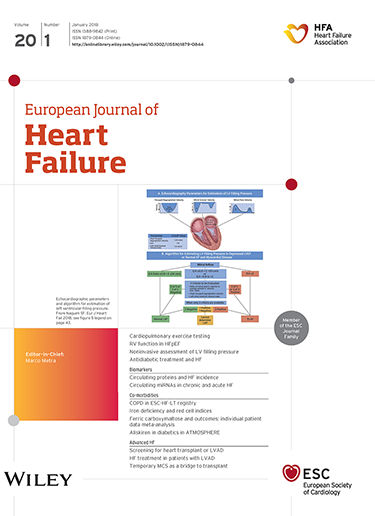Cardiac implantable electronic and other monitoring devices in continuous-flow left ventricular assist device patients. A clinical consensus statement of the Heart Failure Association and the European Heart Rhythm Association of the ESC
IF 16.9
1区 医学
Q1 CARDIAC & CARDIOVASCULAR SYSTEMS
引用次数: 0
Abstract
The management of heart failure patients with continuous-flow left ventricular assist device (LVAD) patients is challenging. While one third of these patients are recipients of cardiac implantable electronic devices (CIEDs), the risk for atrial and ventricular arrhythmias may coexist. The lack of large datasets and dedicated randomized controlled trials (RCTs) focusing on LVAD and CIED implantation and management has brought medical centres to develop their own protocols and guidelines. This clinical consensus statement of the Heart Failure Association and the European Heart Rhythm Association of the ESC is a joint effort to summarize the current literature and provide advice on patient management within this field.求助全文
约1分钟内获得全文
求助全文
来源期刊

European Journal of Heart Failure
医学-心血管系统
CiteScore
27.30
自引率
11.50%
发文量
365
审稿时长
1 months
期刊介绍:
European Journal of Heart Failure is an international journal dedicated to advancing knowledge in the field of heart failure management. The journal publishes reviews and editorials aimed at improving understanding, prevention, investigation, and treatment of heart failure. It covers various disciplines such as molecular and cellular biology, pathology, physiology, electrophysiology, pharmacology, clinical sciences, social sciences, and population sciences. The journal welcomes submissions of manuscripts on basic, clinical, and population sciences, as well as original contributions on nursing, care of the elderly, primary care, health economics, and other related specialist fields. It is published monthly and has a readership that includes cardiologists, emergency room physicians, intensivists, internists, general physicians, cardiac nurses, diabetologists, epidemiologists, basic scientists focusing on cardiovascular research, and those working in rehabilitation. The journal is abstracted and indexed in various databases such as Academic Search, Embase, MEDLINE/PubMed, and Science Citation Index.
 求助内容:
求助内容: 应助结果提醒方式:
应助结果提醒方式:


